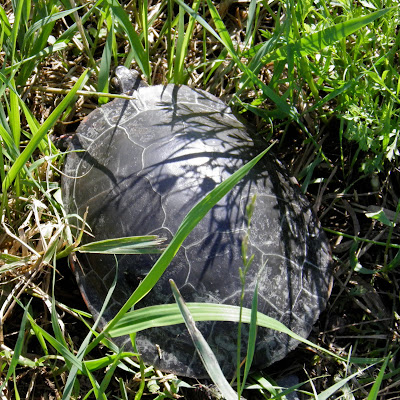
This morning the Montezuma Audubon Center (MAC) held its monthly scheduled event in the Guided Hike series with Naturalist Dave Spier. Today's walk around the MAC while short in distance was long in information. Dave identified and explained the origin of several flowers growing along the trail.
Before joining the group at the MAC I drove down Carncross Road. There was an osprey gliding in the thermals and a great blue heron wading in an irrigation ditch. A painted turtle impeded my progress as I waited for it to cross the road.


Then I went over to Martens Tract.

There from the observation knoll I saw a Song Sparrow, a Swamp Sparrow and a Common Moorhen.


Arrived at the MAC at 10:30 AM. Dave assembled our group (Anne-Marie from Syracuse, Alisha and her son, Jake, from Atlanta, GA, and myself) in the foyer. After asking if anyone had a special preference for the day (there were none), Dave lead us out through the parking lot to the lane.
Once on the lane we were joined by Elizabeth and her children, Teddy and Owen. Shortly thereafter this family was joined by a woman and her daughter. Evidently their preference was to view birds so they went on ahead.
The first plants that Dave pointed out were fleabane, pink clover and rough-fruited cinquefoil. Dave shared how people once mixed fleabane with bedstraw to keep bugs out of their mattresses.
Someone asked about a clump of grasses. Dave identified it as timothy grass. This lead to a discussion of monocots versus dicots. Dave had Jake explain the differences between the "cots" to the group.
Dave indicated abnormal outgrowth on a plant. Anne-Marie identified as a gall and explained its function.
We then came upon some St. John's wort. Dave mentioned that St John's wort is used by some as a herbal treatment for mild depression.

Anne-Marie spotted a butterfly. Dave said it was a Baltimore Checkerspot, getting its name from the royal colors of Lord Baltimore.

Leaving the lane we headed west on the trail towards the ponds. There on the path border were Bindweed and Birdsfoot Trefoil. Evidently Bindweed gave farm equipment problems. Using a Birdsfoot Trefoil bud Dave made a shadow on this palm to illustrate how the plant looks like a bird's foot.


Halfway down the trail we diverted to the small pond that is on the shortcut path to the center. There Jake found two frogs basking in the sun. Dave pointed out the bulrush, cattails and Grass-leaved Arrowhead.





Got back on the trail and walked to to the ponds. Dave drew our attention to Burr Weed and Knapweed.


In the North Pond was a Trumpeter Swan, a Pied-billed Grebe and several Red-winged Blackbirds. A great Blue Heron took off from the South Pond and flew over heading East.


Since we had gone past the scheduled time and some of us had commitments the group walked back to the center and dispersed.
Dave emailed me this butterfly capture.


No comments:
Post a Comment